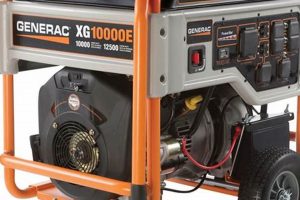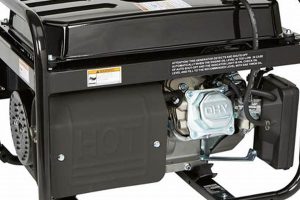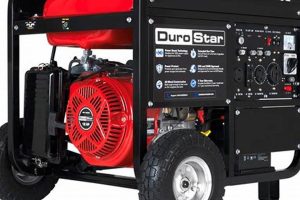Portable generator sound levels are typically measured in decibels (dB). A generator’s noise output can range from a quiet hum, comparable to normal conversation, to a loud roar similar to a motorcycle or a lawnmower. This sound output depends on several factors, including the generator’s size (wattage), engine type, load, and whether or not it incorporates noise-reduction technology. For example, a smaller inverter generator designed for camping might produce around 50 dB, while a larger, conventional generator powering a home during an outage could reach 70 dB or more at a similar distance.
Understanding a portable generator’s sound level is crucial for a variety of reasons. Excessive noise can be disruptive to neighbors, violate local noise ordinances, and impact the usability of the generator, especially in sensitive environments like campsites or residential areas. Historically, generators were notoriously loud. However, technological advancements have led to quieter models, making them more suitable for a wider range of applications. This progress reflects the growing need for power solutions that balance functionality with minimal noise pollution.
The following sections will explore the factors influencing generator noise, various methods of sound reduction, and recommendations for selecting a generator with an appropriate sound level for specific needs. Additionally, the legal aspects of generator noise and available resources for noise measurement will be discussed.
Tips for Managing Portable Generator Noise
Minimizing noise pollution from portable generators enhances their usability and promotes peaceful coexistence with surrounding environments. The following tips provide practical guidance for selecting and operating generators with noise levels in mind.
Tip 1: Consider Inverter Generators: Inverter generators generally operate more quietly than conventional generators, especially under lighter loads. Their variable engine speed adjusts to the power demand, reducing unnecessary noise.
Tip 2: Check Decibel Ratings: Manufacturers often provide decibel ratings. Look for models with lower dB levels, typically indicated at a specific distance (e.g., 23 feet or 7 meters). Compare ratings across different models before purchasing.
Tip 3: Utilize Sound-Dampening Enclosures: Purpose-built enclosures or baffles can significantly reduce noise by absorbing and deflecting sound waves. These can be purchased commercially or constructed using sound-absorbing materials.
Tip 4: Maintain Proper Distance: Positioning the generator farther from living spaces and neighboring properties helps minimize noise impact. Strategic placement behind barriers or natural sound buffers like shrubs can further mitigate noise propagation.
Tip 5: Manage the Load: Avoid overloading the generator. Operating it at or near its maximum capacity increases engine strain and noise output. Distribute power needs efficiently to prevent exceeding the generator’s rated wattage.
Tip 6: Regular Maintenance: A well-maintained generator operates more efficiently and quietly. Adhere to the manufacturer’s recommended maintenance schedule, including oil changes, air filter cleaning, and spark plug replacements.
Tip 7: Choose the Right Size: Select a generator that adequately meets power requirements without significant excess capacity. Oversized generators often operate at lower efficiency and produce more noise than necessary.
By implementing these strategies, users can effectively manage generator noise, minimizing disturbance and maximizing the benefits of portable power generation.
Understanding and mitigating noise levels are integral aspects of responsible generator ownership and operation. The final section will provide concluding remarks and emphasize the importance of noise considerations in the selection and use of portable generators.
1. Decibel (dB) rating
The decibel (dB) rating is the primary metric for quantifying the sound intensity of a portable generator. Understanding this rating is essential for selecting a generator that meets noise requirements and complies with local noise ordinances. A lower dB rating signifies quieter operation, contributing to a more peaceful environment.
- Logarithmic Scale
The decibel scale is logarithmic, meaning a 10 dB increase represents a tenfold increase in sound intensity. For example, a 70 dB generator is ten times louder than a 60 dB generator and 100 times louder than a 50 dB generator. This logarithmic nature highlights the significant impact even small differences in dB ratings can have on perceived loudness.
- Distance from Source
dB ratings are typically measured at a specific distance from the generator, often 7 meters (23 feet). Sound intensity decreases with distance, so it’s crucial to consider the intended operating location and the distance to noise-sensitive areas when evaluating dB ratings. A generator rated at 60 dB at 7 meters will be considerably louder at closer proximity.
- Comparison to Common Sounds
Contextualizing dB ratings with familiar sounds aids in understanding their practical implications. A 50 dB generator is comparable to normal conversation, while a 70 dB generator is similar to a vacuum cleaner or busy traffic. A 90 dB generator approaches the loudness of a motorcycle or lawnmower. These comparisons provide a tangible sense of the noise levels associated with different dB ratings.
- Impact on Regulations and Comfort
Many jurisdictions have noise ordinances restricting generator operation based on dB levels, especially during certain hours. Choosing a generator with a dB rating compliant with local regulations is essential for avoiding penalties. Furthermore, lower dB ratings contribute to increased user comfort and minimize disturbance to neighbors and the surrounding environment.
By considering these facets of the dB rating, consumers can make informed decisions about selecting and operating portable generators while minimizing noise pollution and ensuring compliance with regulations. Prioritizing lower dB ratings contributes significantly to a quieter and more considerate approach to portable power generation.
2. Generator size/wattage
Generator size, typically measured in watts, directly correlates with engine size and, consequently, noise output. Larger generators with higher wattage capacities generally require larger engines to produce more power, leading to increased noise levels. Understanding this relationship is crucial for selecting a generator that balances power needs with acceptable noise levels.
- Power Output and Engine Size
The wattage rating of a generator reflects its maximum power output. Higher wattage necessitates a larger engine with more cylinders and greater displacement, resulting in increased combustion and exhaust noise. For instance, a 1,000-watt generator typically has a smaller, quieter engine than a 7,000-watt generator, which requires a larger, more powerful and thus louder engine to deliver the necessary power.
- Operating Load and Noise Levels
While a larger generator might be louder at full capacity, it may operate more quietly than a smaller generator under the same load. A smaller generator running near its maximum capacity will strain the engine and produce more noise, whereas a larger generator operating at a lower percentage of its capacity might run more smoothly and quietly. This highlights the importance of matching generator size to power needs rather than opting for excessive capacity.
- Inverter Technology and Efficiency
Inverter generators offer improved efficiency and quieter operation, even in higher wattage models. Inverter technology allows the engine speed to adjust dynamically to the load, reducing unnecessary engine strain and noise. This makes inverter generators a viable option for noise-sensitive environments even when higher power output is required. A 3,000-watt inverter generator might be considerably quieter than a comparably sized conventional generator, demonstrating the noise-reducing benefits of inverter technology.
- Fuel Consumption and Run Time
Larger generators typically consume more fuel and may have shorter run times at full load compared to smaller generators operating under lighter loads. While not directly related to noise output, this factor should be considered alongside wattage and noise levels when selecting a generator. Balancing power needs, noise output, and fuel efficiency is crucial for selecting the most suitable generator for a specific application.
Careful consideration of generator size/wattage alongside other factors like engine type and noise reduction features is essential for selecting a generator that effectively balances power requirements with acceptable noise levels. Choosing a generator with appropriate wattage for the intended use minimizes both noise pollution and unnecessary fuel consumption.
3. Engine type (inverter/conventional)
Engine type significantly influences the noise level of a portable generator. Conventional generators utilize a constant-speed engine, typically running at 3600 RPM, regardless of the power demand. This constant high-speed operation contributes to consistent noise output, even under light loads. Inverter generators, conversely, employ variable-speed technology. The engine speed adjusts dynamically to match the power demand, resulting in lower engine speeds and reduced noise output, especially under lighter loads. This fundamental difference in engine operation directly impacts perceived loudness. A conventional generator powering a small lightbulb will produce nearly the same noise level as when powering multiple appliances, while an inverter generator adjusts its engine speed, resulting in substantially quieter operation under the lighter load.
This distinction becomes particularly relevant in noise-sensitive environments such as campsites or residential areas. Inverter generators offer a substantial advantage in these contexts by minimizing noise pollution. Consider a scenario requiring power for a few small electronic devices: an inverter generator might operate at a whisper-quiet 50 dB, while a conventional generator would maintain its consistent, louder output, potentially exceeding 70 dB. This difference can be crucial for maintaining peaceful coexistence with neighbors or enjoying the tranquility of nature. Furthermore, the consistent high-speed operation of conventional generators can lead to increased fuel consumption and wear and tear on the engine compared to the variable-speed operation of inverter generators. This translates to potential cost savings and extended engine life for inverter models.
The choice between a conventional and inverter generator depends on specific needs and priorities. While conventional generators offer a simpler, often more cost-effective solution for high-power demands, inverter generators excel in noise-sensitive environments and situations with fluctuating power needs. Understanding the impact of engine type on noise output empowers informed decision-making, enabling selection of the most appropriate generator for a given application, balancing power requirements with noise considerations and overall operating efficiency.
4. Load and operating conditions
A portable generator’s operating load and conditions significantly influence its noise output. The amount of power being drawn from the generator, combined with environmental factors and maintenance status, directly impacts engine strain and, consequently, noise levels. Understanding this relationship is crucial for managing generator noise effectively and ensuring optimal performance.
- Power Demand
The generator’s load, representing the amount of power being consumed by connected devices, directly impacts noise output. Higher power demands force the engine to work harder, leading to increased noise levels. For example, a generator powering a single small appliance will operate much more quietly than when powering multiple high-wattage devices simultaneously. Matching the generator’s capacity to the anticipated load minimizes unnecessary strain and noise.
- Altitude and Temperature
Environmental conditions, particularly altitude and temperature, can affect engine performance and noise. At higher altitudes, the thinner air reduces engine efficiency, potentially requiring the engine to work harder and produce more noise. Similarly, high ambient temperatures can strain the engine, leading to increased noise output. Operating the generator within its specified temperature and altitude ranges optimizes performance and minimizes noise.
- Maintenance and Upkeep
Regular maintenance, including oil changes, air filter cleaning, and spark plug replacement, is essential for optimal generator performance and noise reduction. A poorly maintained generator may operate less efficiently, causing the engine to work harder and produce more noise. Adhering to the manufacturer’s recommended maintenance schedule helps ensure smooth, quiet operation.
- Fuel Quality
Using the correct fuel type and ensuring fuel quality contributes to efficient combustion and reduced noise. Using stale or contaminated fuel can negatively impact engine performance, leading to increased noise and potential damage. Always use fresh, clean fuel as recommended by the manufacturer to maintain optimal performance and minimize noise output.
Careful consideration of load, operating conditions, and maintenance practices is essential for managing portable generator noise effectively. By understanding these factors and operating the generator within its optimal parameters, users can minimize noise pollution and ensure efficient, reliable power generation.
5. Noise reduction features
Noise reduction features play a critical role in mitigating the sound output of portable generators. These features directly impact how loud a generator operates, influencing its suitability for various applications and environments. Several design elements contribute to noise reduction, each addressing different aspects of sound generation and propagation. Understanding these features enables informed decisions about generator selection and operation, balancing power needs with noise considerations.
Mufflers are a standard noise reduction feature, attenuating engine exhaust noise. Different muffler designs offer varying levels of noise suppression. Advanced mufflers, incorporating features like baffles and resonators, can significantly reduce exhaust noise compared to basic designs. Sound-dampening enclosures provide another layer of noise reduction by enclosing the generator within a sound-absorbing structure. These enclosures typically utilize materials like foam or acoustic blankets to absorb and dissipate sound waves, minimizing noise leakage. Engine design and mounting also influence noise levels. Modern engines, particularly those found in inverter generators, are often designed with noise reduction in mind. Features like optimized combustion processes and vibration-dampening engine mounts contribute to quieter operation. For example, a generator equipped with a high-performance muffler and enclosed within a sound-dampening enclosure can operate significantly quieter than a comparable model lacking these features, even under similar load conditions. This reduction in noise can be the difference between compliance with noise ordinances and disruptive operation.
The practical significance of noise reduction features extends beyond simple noise mitigation. Quieter generators enhance usability in noise-sensitive environments, minimizing disturbance to neighbors and promoting peaceful operation in residential areas, campsites, or during outdoor events. Furthermore, reduced noise levels contribute to improved operator comfort, particularly during extended operation. Choosing a generator with effective noise reduction features is essential for balancing power needs with environmental considerations and promoting responsible generator use. Prioritizing noise reduction features contributes to a quieter, more considerate approach to portable power generation, enabling seamless integration of portable power solutions into diverse settings without compromising peace and tranquility.
Frequently Asked Questions about Portable Generator Noise
This section addresses common inquiries regarding portable generator noise levels, aiming to provide clear and concise information for informed decision-making.
Question 1: How is generator noise measured?
Generator noise is typically measured in decibels (dB), a logarithmic unit quantifying sound intensity. Measurements are usually taken at a fixed distance, often 7 meters (23 feet), to standardize comparisons between models.
Question 2: What is considered a quiet generator?
Generators producing less than 60 dB at 7 meters are generally considered quiet. Inverter generators often fall within this range, making them suitable for noise-sensitive environments.
Question 3: Do all generators require sound-dampening enclosures?
While not all generators require enclosures, they significantly reduce noise output. Enclosures are particularly beneficial for conventional generators, which tend to be louder than inverter models.
Question 4: How does generator size relate to noise levels?
Larger generators with higher wattage capacities generally produce more noise due to larger engines required for increased power output. Matching generator size to power needs helps minimize unnecessary noise.
Question 5: Can local ordinances restrict generator usage based on noise?
Many jurisdictions have noise ordinances limiting generator operation, especially during certain hours. Checking local regulations before purchasing or operating a generator is essential for compliance.
Question 6: How can one minimize generator noise during operation?
Several strategies can minimize noise, including using sound-dampening enclosures, positioning the generator away from noise-sensitive areas, and maintaining proper distance from neighbors and buildings. Regular maintenance also helps optimize generator operation and reduce noise.
Understanding generator noise characteristics is essential for responsible operation. Careful consideration of dB ratings, generator type, and noise reduction features ensures appropriate selection and usage, minimizing noise pollution and maximizing the benefits of portable power generation.
For further information, consult resources such as manufacturer specifications, online forums dedicated to generator discussions, and local authorities regarding noise ordinances.
How Loud Is a Portable Generator
Portable generator noise levels, a critical factor influencing their suitability for various applications, depend significantly on factors such as wattage, engine type (conventional or inverter), load, and incorporated noise reduction features. Decibel (dB) ratings provide a standardized measure for comparison, with lower dB values indicating quieter operation. Understanding the logarithmic nature of the decibel scale is crucial for interpreting these ratings accurately. Inverter generators generally operate more quietly than conventional counterparts due to their variable-speed technology, adjusting engine speed to match power demand and minimizing unnecessary noise. Furthermore, strategic placement, sound-dampening enclosures, and regular maintenance contribute significantly to noise reduction during operation. Local noise ordinances often regulate generator usage based on dB levels and operating hours, underscoring the importance of compliance for responsible operation.
Careful consideration of noise output is essential for selecting and operating a portable generator effectively. Balancing power requirements with noise considerations ensures minimal disruption to surrounding environments and promotes harmonious coexistence. Prioritizing quieter operation, through informed model selection and appropriate noise mitigation strategies, reflects a commitment to responsible power generation practices and contributes to a more peaceful soundscape for all.






